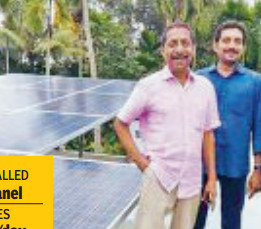This actor has turned producer – of power
Actor-director Sreenivasan has thus far been known to Mollywood fans for his films; they’ll now also know him as a power generator. Six months ago, Sreenivasan installed a 10 KW solar unit at his home in Kandanad, Kochi. Ranged over 1,500 sqft, the panels were not only designed to meet all his home’s energy needs, but to contribute the excess to the state electricity grid as well.
After a 6-month wait for the Kerala State Electricity Board (KSEB) to install a two-way meter to record the units of power flowing into the grid, the actor finally got it up and running last week and is all set to count himself among the state’s power suppliers.
“The new system was fixed only to contribute to the national grid, the quid pro quo being subsidized domestic power,” says Sreenivasan. However, the long wait soured the experience a little. “I can’t say I had a pleasant experience. There was no explanation for the delay,” he complains.
The actor wants to spread the message of alternative energy. “I am not sure if I will be able to generate and sell power every day. But, if I am not at home for a month and not using power, I can sell all the electricity generated (40 units per day) to the KSEB, and the amount earned can subsidize my consumption of KSEB power for other months,” he reasons.

HAS INSTALLED 10KW panel GENERATES 40 units/day
Sreenivasan has a larger vision than cheaper electricity bills. “If we can universalise this system of production, several new proposed hydroelectric projects can be shelved,” he says.
S Shyamkumar, whose company Innovation Experience fitted the solar panels at the actor’s place, says the technology is affordable now even for the middle class. “What we lack is awareness,” he points out. Incidentally, Shyamkumar also installed a similar facility at former Infosys chief Kris Gopalakrishnan’s house in Thiruvananthapuram.
At Sreenivasan’s house, the solar panels are a natural extension of the actor’s efforts to minimize his domestic carbon footprint. His 590-sq-m bungalow has energy-efficient AC VRV units and lighting, low-flow water fixtures, rain-water harvesting, and a highly reflective roof to reduce energy consumption by over 16% of general green homes guidelines.
 India Clean Energy Clean Energy for India – the world's fastest growing economy
India Clean Energy Clean Energy for India – the world's fastest growing economy